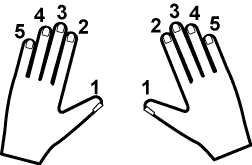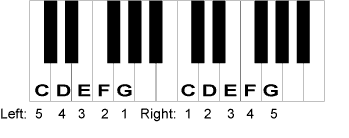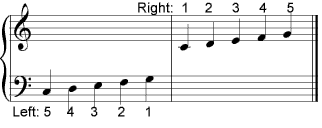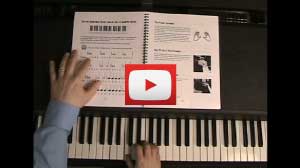The Five Finger Position on the Piano
And What It Implies
Finger Numbers

Before we discuss the five finger position, let's review the finger numbers:
On both the left and right hands, the thumbs are #1, index fingers are #2, the middle fingers are #3, the ring fingers are #4, and the pinky fingers are #5.
What the Finger Numbers Imply
The finger numbers in a piece of music tell you:
1. What finger is playing a particular note.
2. What five-finger position your hand will be in.
For example, if the music says to put your right hand first finger (thumb) on "A", then from that it is implied that your second finger is on "B," your third finger is on "C," your fourth finger is on "D," and your fifth finger will play "E."
The key signature must be taken into consideration. If in the previous example, the music is the key of "Bb," then your right hand second finger would play "Bb" instead of "B," and your fifth finger would play "Eb" instead of "E."
Sometimes the music requires you to change hand positions. For example, you may be in the "A" five finger position as stated above, but a musical phrase has the note "F" below that "A." If the phrase works best starting with the first finger on the "F," (because the notes move up) then often times no number will be given; because it is the most obvious choice for fingering. The same works for reaching up to a higher note outside of the position, and the fifth finger is the obvious choice (because the notes move down).
The C Major Five Finger Position

This is the position that most beginning pianists start in. In The C major five-finger position, both hands will play notes C, D, E, F and G. Right hand #1 (thumb) is on "C", and #5 ("pinky") is on "G." Left hand is the opposite: left hand #1 (thumb) is on "G", and #5 ("pinky") is on "C."
Here's how it looks on the staff:

Start Playing Piano Today with the Piano Guide Quick Start Course!
Easy to follow step-by-step lessons designed for adult beginners. The next best thing to private lessons!
What You'll Learn:
- Notes on the piano/keyboard
- Proper fingering
- C major scale
- Chords
- How to read music
- And much more!

Video lessons - watch as I play everything for you.

